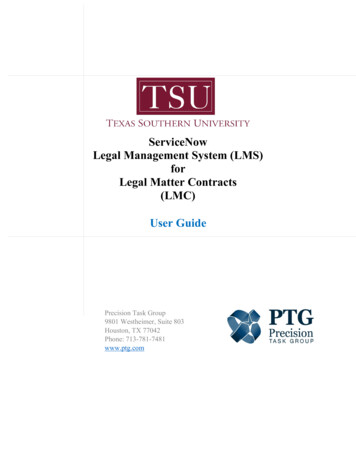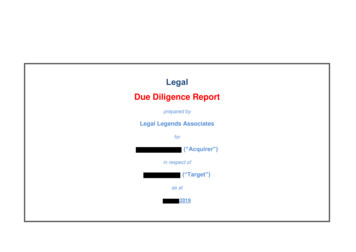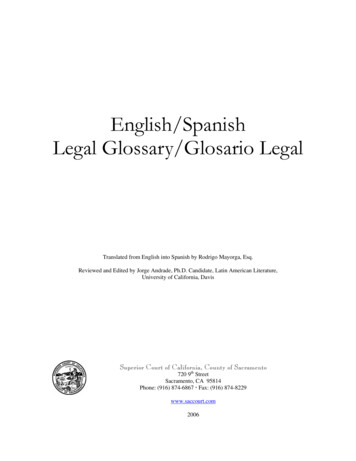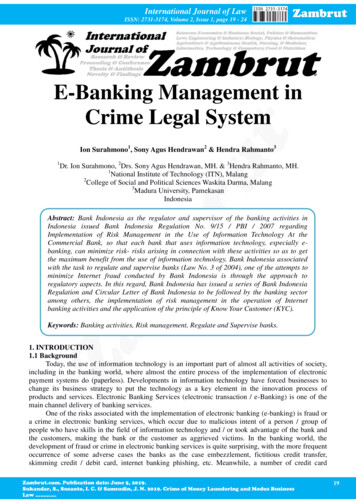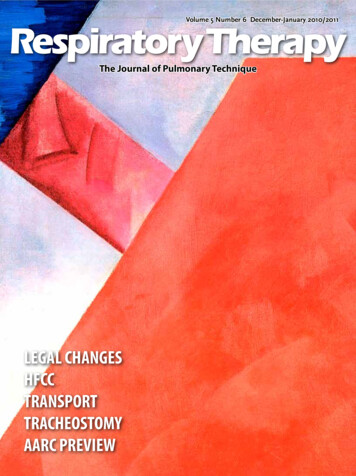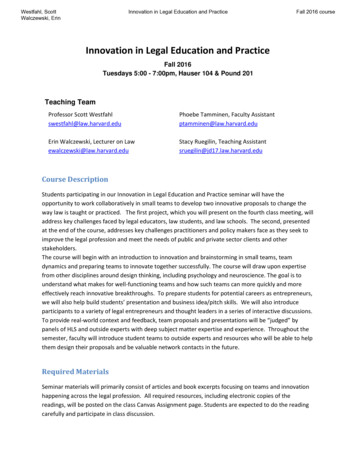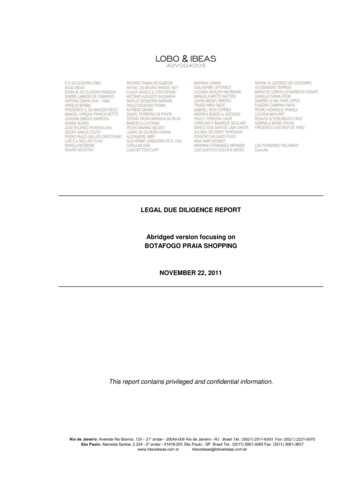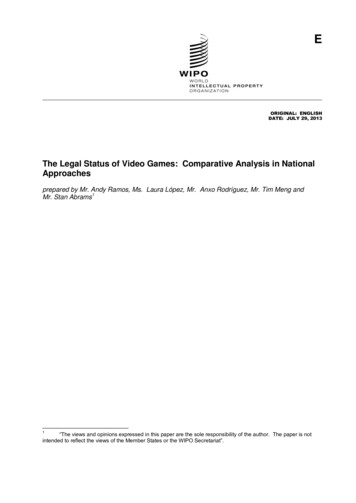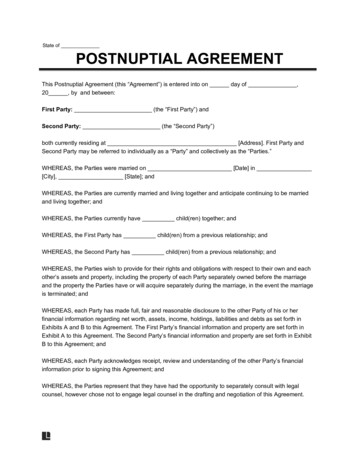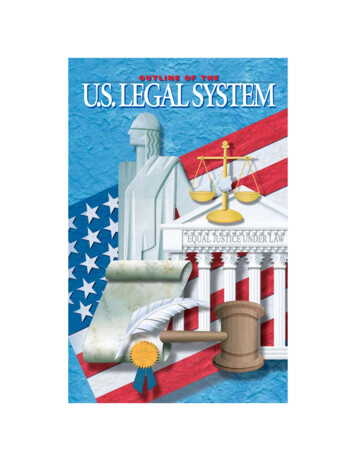
Transcription
OOUUTTLLIINNEE OOFF TTHHEEU.S.LEGAL SYSTEM
OUTLINE OF THEU.S.LEGAL SYSTEMBureau of International Information ProgramsUnited States Department of Statehttp://usinfo.state.gov2004
OUTLINE OF THEU.S.LEGAL SYSTEMCONTENTSINTRODUCTIONThe U.S. Legal System . . . . . . . . . . . . . . . . . . . . . . . . . . . . . . . . . . . . . . . . . 4CHAPTER 1History and Organization of the Federal Judicial System . . . . . . . . . 18CHAPTER 2History and Organization of State Judicial Systems . . . . . . . . . . . . . . 44CHAPTER 3Jurisdiction and Policy-Making Boundaries . . . . . . . . . . . . . . . . . . . . 56CHAPTER 4Lawyers, Litigants, and Interest Groups in the Judicial Process . . . . 72CHAPTER 5The Criminal Court Process . . . . . . . . . . . . . . . . . . . . . . . . . . . . . . . . . . . 90CHAPTER 6The Civil Court Process . . . . . . . . . . . . . . . . . . . . . . . . . . . . . . . . . . . . . 118CHAPTER 7Federal Judges . . . . . . . . . . . . . . . . . . . . . . . . . . . . . . . . . . . . . . . . . . . . . . 140CHAPTER 8Implementation and Impact of Judicial Policies . . . . . . . . . . . . . . . . 158The Constitution of the United States . . . . . . . . . . . . . . . . . . . . . . . . . 177Amendments to the Constitution of the United States . . . . . . . . . . . 192Glossary . . . . . . . . . . . . . . . . . . . . . . . . . . . . . . . . . . . . . . . . . . . . . . . . . . . 204Bibliography . . . . . . . . . . . . . . . . . . . . . . . . . . . . . . . . . . . . . . . . . . . . . . . 212Index . . . . . . . . . . . . . . . . . . . . . . . . . . . . . . . . . . . . . . . . . . . . . . . . . . . . . . 214
INTRODUCTIONTHEU.S.LEGALSYSTEMIn this scene from an 1856painting by Junius Brutus Searns,George Washington (standing,right) addresses the ConstitutionalConvention, whose membersdrafted and signed the U.S.Constitution on September 17,1787. The Constitution is theprimary source of law in theUnited States.
6OUTLINE OF THE U.S. LEGAL SYSTEMEvery business day, courts throughoutthe United States render decisions thattogether affect many thousands ofpeople. Some affect only the parties toa particular legal action, but others adjudicate rights, benefits, and legalprinciples that have an impact on virtually all Americans. Inevitably, manyAmericans may welcome a given ruling while others — sometimes manyothers — disapprove. All, however, accept the legitimacy of these decisions,and of the courts’ role as final interpreter of the law. There can be nomore potent demonstration of thetrust that Americans place in the ruleof law and their confidence in the U.S.legal system.The pages that follow survey thatsystem. Much of the discussion explains how U.S. courts are organizedand how they work. Courts are centralto the legal system, but they are notthe entire system. Every day acrossAmerica, federal, state, and localcourts interpret laws, adjudicate disputes under laws, and at times evenstrike down laws as violating the fundamental protections that the Constitution guarantees all Americans. Atthe same time, millions of Americanstransact their day-to-day affairs without turning to the courts. They, too,rely upon the legal system. The youngcouple purchasing their first home,two businessmen entering into a contract, parents drawing up a will to provide for their children — all requirethe predictability and enforceablecommon norms that the rule of lawprovides and the U.S. legal systemguarantees.This introduction seeks to familiarize readers with the basic structureand vocabulary of American law.Subsequent chapters add detail, andafford a sense of how the U.S. legalsystem has evolved to meet theneeds of a growing nation and itsever more complex economic andsocial realities.A FEDERAL LEGAL SYSTEM:Overviewhe American legal system hasseveral layers, more possiblythan in most other nations.One reason is the division betweenfederal and state law. To understandthis, it helps to recall that the UnitedStates was founded not as one nation,but as a union of 13 colonies, eachclaiming independence from theBritish Crown. The Declaration ofIndependence (1776) thus spoke of“the good People of these Colonies”but also pronounced that “theseUnited Colonies are, and of Rightought to be, FREE AND INDEPENDENT STATES.” The tension betweenone people and several states is aperennial theme in American legalhistory. As explained below, the U.S.Constitution (adopted 1787, ratified1788) began a gradual and at timesT
INTRODUCTION 7hotly contested shift of power andlegal authority away from the statesand toward the federal government.Still, even today states retain substantial authority. Any student of theAmerican legal system must understand how jurisdiction is apportionedbetween the federal government andthe states.The Constitution fixed many of theboundaries between federal and statelaw. It also divided federal poweramong legislative, executive, and judicial branches of government (thuscreating a “separation of powers”between each branch and enshrininga system of “checks-and-balances”to prevent any one branch fromoverwhelming the others), each ofwhich contributes distinctively to thelegal system. Within that system, theConstitution delineated the kinds oflaws that Congress might pass.As if this were not sufficiently complex, U.S. law is more than the statutespassed by Congress. In some areas,Congress authorizes administrativeagencies to adopt rules that add detailto statutory requirements. And theentire system rests upon the traditional legal principles found in EnglishCommon Law. Although both theConstitution and statutory law supersede common law, courts continueto apply unwritten common lawprinciples to fill in the gaps where theConstitution is silent and Congresshas not legislated.SOURCES OF FEDERAL LAWThe United States ConstitutionSupremacy of Federal Lawuring the period 1781–88, anagreement called the Articlesof Confederation governedrelations among the 13 states. It established a weak national Congress andleft most authority with the states. TheArticles made no provision for a federal judiciary, save a maritime court, although each state was enjoined tohonor (afford “full faith and credit”to) the rulings of the others’ courts.The drafting and ratification ofthe Constitution reflected a growingconsensus that the federal governmentneeded to be strengthened. The legalsystem was one of the areas wherethis was done. Most significant wasthe “supremacy clause,” found inArticle VI:This Constitution, and the Laws ofthe United States which shall bemade in Pursuance thereof; and allTreaties made, or which shall bemade, under the Authority of theUnited States, shall be the supremeLaw of the Land; and the Judges inevery State shall be bound thereby,any Thing in the Constitution orLaws of any State to the Contrarynotwithstanding.DThis paragraph established the firstprinciple of American law: Where the
8OUTLINE OF THE U.S. LEGAL SYSTEMfederal Constitution speaks, no statemay contradict it. Left unclear washow this prohibition might apply tothe federal government itself, and therole of the individual state legal systems in areas not expressly addressedby the new Constitution. Amendments would supply part of the answer, history still more, but even todayAmericans continue to wrestle withthe precise demarcations between thefederal and state domains.Each Branch Plays a Role in theLegal SystemWhile the drafters of the Constitutionsought to strengthen the federal government, they feared strengthening ittoo much. One means of restrainingthe new regime was to divide it intobranches. As James Madison explainedin Federalist No. 51, “usurpations areguarded against by a division of thegovernment into distinct and separatedepartments.” Each of Madison’s “departments,” legislative, executive, andjudiciary, received a measure ofinfluence over the legal system.LegislativeThe Constitution vests in Congress thepower to pass legislation. A proposalconsidered by Congress is called a bill.If a majority of each house of Congress — two-thirds should the President veto it — votes to adopt a bill, itbecomes law. Federal laws are knownas statutes. The United States Code is a“codification” of federal statutory law.The Code is not itself a law, it merelyThe Constitution has vested the power to pass legislation in Congress, here gathered in a jointsession for President George W. Bush’s budget speech in 2001. The executive power, in turn,is entrusted to the President.
INTRODUCTION 9presents the statutes in a logicalarrangement. Title 20, for instance,contains the various statutes pertaining to Education, and Title 22 thosecovering Foreign Relations.Congress’ lawmaking power is limited. More precisely, it is delegated bythe American people through theConstitution, which specifies areaswhere Congress may or may not legislate. Article I, Section 9 of the Constitution forbids Congress from passingcertain types of laws. Congress maynot, for instance, pass an “ex post facto”law (a law that applies retroactively, or“after the fact”), or levy a tax on exports. Article I, Section 8 lists areaswhere Congress may legislate. Some ofthese (“To establish Post Offices”) areLaws passed by one of the 50 statelegislatures, such as the New York StateAssembly shown above during a roll call,apply only to the citizens of that state oroutsiders who reside or do business there.quite specific but others, most notably,“To regulate Commerce with foreignNations, and among the several States,”are less so. Obviously the power to interpret the less precise delegations isextremely important. Early in theyoung republic’s history, the judiciarybranch assumed this role and thus secured an additional and extremelyvital role in the U.S. legal system.JudicialAs with the other branches, the U.S.judiciary possesses only those powersthe Constitution delegates. The Constitution extended federal jurisdictiononly to certain kinds of disputes. Article III, Section 2 lists them. Two of themost significant are cases involving aquestion of federal law (“all Cases inLaw and Equity, arising under thisConstitution, the Laws of the UnitedStates, and Treaties made ”) and “diversity” cases, or disputes between citizens of two different states. Diversityjurisdiction allows each party to avoidlitigating his case before the courts ofhis adversary’s state.A second judicial power emerged inthe Republic’s early years. As explainedin Chapter 2, the U.S. Supreme Courtin the case of Marbury v. Madison(1803) interpreted its delegated powers to include the authority to determine whether a statute violated theConstitution and, if it did, to declaresuch a law invalid. A law may be unconstitutional because it violates rightsguaranteed to the people by the Con-
10OUTLINE OF THE U.S. LEGAL SYSTEMstitution, or because Article I did notauthorize Congress to pass that kindof legislation.The power to interpret the constitutional provisions that describewhere Congress may legislate is thusvery important. Traditionally, Congress has justified many statutes asnecessary to regulate “commerce among the several States,” or interstatecommerce. This is an elastic concept,difficult to describe with precision. Indeed, one might for nearly any statutedevise a plausible tie between its objectives and the regulation of interstatecommerce. At times, the judicialbranch interpreted the “commerceclause” narrowly. In 1935, for instance,the Supreme Court invalidated afederal law regulating the hours andwages of workers at a New Yorkslaughterhouse because the chickensprocessed there all were sold to NewYork butchers and retailers and hencenot part of interstate commerce. Soonafter this, however, the Supreme Courtbegan to afford President Franklin D.Roosevelt’s New Deal programs morelatitude, and today the federal courtscontinue to interpret broadly thecommerce power, although not sobroadly as to justify any legislationthat Congress might pass.ExecutiveArticle II entrusts to the Presidentof the United States “the executivePower.” Under President GeorgeWashington (1789–1801), the entireexecutive branch consisted of thePresident, Vice President, and theDepartments of State, Treasury, War,and Justice. As the nation grew, the executive branch grew with it. Todaythere are 15 Cabinet-level Departments. Each houses a number ofBureaus, Agencies, and other entities.Still other parts of the executivebranch lie outside these Departments.All exercise executive power delegatedby the President and thus are responsible ultimately to him.In some areas, the relationship between the executive and the other twobranches is clear. Suppose one or moreindividuals rob a bank. Congress haspassed a statute criminalizing bankrobbery (United States Code, Title 18,Section 2113*). The Federal Bureauof Investigation (FBI), a bureau withinthe Department of Justice, wouldinvestigate the crime. When it apprehended one or more suspects, aFederal Prosecutor (also Departmentof Justice) would attempt to prove thesuspect’s guilt in a trial conducted by aU.S. District Court.The bank robbery case is a simpleone. But as the nation modernized and* Technically, the statute applies only to abank that is federally chartered, insured, or amember of the Federal Reserve System.Possibly every bank in the United Statesmeets these criteria, but one that did not,and could not be construed as impactinginterstate commerce, would not be subjectto federal legislation. Federal statutestypically recite a jurisdictional basis: in thiscase, the federal charter requirement.
INTRODUCTION 11Federal and state courts hear two kinds of disputes: civil and criminal. Here an attorneyrepresenting landowners in a civil action presents his arguments to the South DakotaSupreme Court.Left, civil law covers statutes pertaining to marriage and divorce. This couple is being marriedin this civil ceremony performed by a judge. At right, a judge in Texas. In the past fewdecades, the U.S. judiciary has expanded to include more women and minorities.
12OUTLINE OF THE U.S. LEGAL SYSTEMgrew, the relationship of the threebranches within the legal systemevolved to accommodate the morecomplex issues of industrial and postindustrial society. The role of the executive branch changed most of all. Inthe bank robbery example, Congressneeded little or no special expertise tocraft a statute that criminalized bankrobbery. Suppose instead that lawmakers wished to ban “dangerous”drugs from the marketplace, or restrict the amount of “unhealthful”pollutants in the air. Congress could, ifit chose, specify precise definitions ofthese terms. Sometimes it does so, butincreasingly Congress instead delegates a portion of its authority to administrative agencies housed in theexecutive branch. The Food and DrugAdministration (FDA) thus watchesover the purity of the nation’s foodand pharmaceuticals and the Environmental Protection Agency (EPA) regulates how industries impact theearth, water, and air.Although agencies possess onlypowers that Congress delegates bystatute, these can be quite substantial.They can include the authority topromulgate rules that define with precision more general statutory terms.A law might proscribe “dangerous”amounts of pollutants in the atmosphere, while an EPA rule defines thesubstances and amounts of each thatwould be considered dangerous.Sometimes a statute empowers anagency to investigate violations of itsrules, to adjudicate those violations,and even to assess penalties!The courts will invalidate a statutethat grants an agency too muchpower. An important statute calledthe Administrative Procedure Act(United States Code Title 5, Section551, et. seq.) explains the proceduresagencies must follow when promulgating rules, judging violations, andimposing penalties. It also lays outhow a party can seek judicial reviewof an agency’s decision.Other Sources of LawThe most obvious sources of American law are the statutes passed byCongress, as supplemented by administrative regulations. Sometimes thesedemarcate clearly the boundaries oflegal and illegal conduct — the bankrobbery example again — but nogovernment can promulgate enoughlaw to cover every situation. Fortunately, another body of legal principles and norms helps fill in the gaps,as explained belowCommon LawWhere no statute or constitutionalprovision controls, both federal andstate courts often look to the commonlaw, a collection of judicial decisions,customs, and general principles thatbegan centuries ago in England andcontinues to develop today. In manystates, common law continues to holdan important role in contract disputes, as state legislatures have not
INTRODUCTION 13seen fit to pass statutes covering everypossible contractual contingency.Judicial PrecedentCourts adjudicate alleged violationsof and disputes arising under thelaw. This often requires that theyinterpret the law. In doing so, courtsconsider themselves bound by howother courts of equal or superior rankhave previously interpreted a law.This is known as the principle of“stare decisis,” or simply precedent. Ithelps to ensure consistency andpredictability. Litigants facing unfavorable precedent, or case law, tryto distinguish the facts of their particular case from those that producedthe earlier decisions.Sometimes courts interpret thelaw differently. The Fifth Amendmentto the Constitution, for instance,contains a clause that “[n]o person shall be compelled in any criminalcase to be a witness against himself.”From time to time, cases arose wherean individual would decline to answera subpoena or otherwise testify onthe grounds that his testimony mightsubject him to criminal prosecution— not in the United States but inanother country. Would the selfincrimination clause apply here? TheU.S. Court of Appeals for the SecondCircuit ruled it did, but the Fourthand Eleventh Circuits held that itdid not.* This effectively meant thatthe law differed depending wherein the country a case arose!Higher-level courts try to resolvethese inconsistencies. The SupremeCourt of the United States, for instance, often chooses to hear a casewhen its decision can resolve a division among the Circuit courts. TheSupreme Court precedent will control, or apply to all the lower federalcourts. In United States v. Balsys, 524U.S. 666 (1998), the Supreme Courtruled that fear of foreign prosecutionis beyond the scope of the SelfIncrimination Clause.**This ruling became the law of theentire nation, including the SecondCircuit. Any federal court subsequently facing the issue was bound by thehigh court ruling in Balsys. Circuitcourt decisions similarly bind all theDistrict Courts within that circuit.Stare decisis also applies in the variousstate court systems. In this way, precedent grows both in volume andexplanatory reach.*The U.S. Circuit Court for the SecondCircuit is an appellate court that hearsappeals from the federal district courts in thestates of New York, Connecticut, andVermont. The Fourth Circuit encompassesMaryland, North Carolina, South Carolina,Virginia, and West Virginia, and the EleventhAlabama, Georgia, and Florida. For moreinformation on the organization of thefederal courts, see chapter 1.**The numbers in this sentence comprisethe citation to the Balsys decision. Theyindicate that the Court issued its ruling in theyear 1998 and that the decision appears involume 524 of a series called United StatesReports, beginning on page 666.
14OUTLINE OF THE U.S. LEGAL SYSTEMDIFFERENT LAWS;DIFFERENT REMEDIESiven this growing body of law,it is useful to distinguishamong different types of lawsand of actions, or lawsuits, broughtbefore the courts and of the remediesthe law affords in each type of case.GCivil/CriminalCourts hear two kinds of disputes:civil and criminal. A civil action involves two or more private parties, atleast one of which alleges a violationof a statute or some provision of common law. The party initiating the lawsuit is the plaintiff; his opponent thedefendant. A defendant can raise acounterclaim against a plaintiff or across-claim agains
American legal system must under-stand how jurisdiction is apportioned between the federal government and the states. The Constitution fixed many of the boundaries between federal and state law. It also divided federal power among legislative, executive, and judi-cial branc
